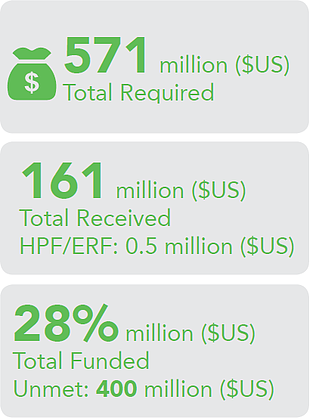Periodic Monitoring Report: 1 January to 30 June 2016
2016 Humanitarian Response Plan - oPt
 The major drivers of humanitarian vulnerability in the occupied Palestinian territory (oPt) remain unchanged. The situation is characterized by a protracted occupation, now in its 50th year, the systematic denial of Palestinian rights, and continuing conflict, punctuated by frequent outbreaks of violence. A pervasive crisis of accountability remains, with no effective remedy for the vast majority of alleged violations of international law, to ensure justice for the victims and to prevent future violations.
The major drivers of humanitarian vulnerability in the occupied Palestinian territory (oPt) remain unchanged. The situation is characterized by a protracted occupation, now in its 50th year, the systematic denial of Palestinian rights, and continuing conflict, punctuated by frequent outbreaks of violence. A pervasive crisis of accountability remains, with no effective remedy for the vast majority of alleged violations of international law, to ensure justice for the victims and to prevent future violations.
Efforts by donors and HCT members to maintain humanitarian space to enable humanitarian operations to deliver to the most vulnerable people are vital. This report covers achievements of humanitarian partners in the first 6 months of 2016, identifies challenges to operations and provides a range of recommendations. In particular, the Government of Israel and relevant Palestinian authorities should fulfil their responsibilities to facilitate the work of humanitarian organizations and donors are encouraged to continue funding the Humanitarian Response Plan in a manner consistent with the priorities agreed by humanitarian partners, including expanding contributions to the Humanitarian Fund (HF).
Key achievements towards Strategic Objectives
- 1.4 million people have received food assistance and 7,000 herder farmilies received livelihood support.
- 160 communities in the West Bank have received regular protective presence. This was a particularly important intervention in the context of closures and increased Israeli Security Forces (ISF) activity in Hebron.
- 7,376 school children (29% girls) and 638 teachers in vulnerable communities in the West Bank provided with protective presence accompaniment around schools and checkpoints.
- 73% of the targeted beneficiaries in Area C of the West Bank provided with access to quality and affordable essential health care.
- Considerable micronutrient supplements provided to children in the Gaza Strip and improved lifesaving neonatal and postnatal services to pregnant women and neonates in the West Bank and in the Gaza Strip.
- 83% households in the West Bank whose homes are subject to demolitions or damage have received immediate shelter/NFIs assistance.
- 54% of targeted people provided with access to drinking water; 15% for the Gaza Strip and 85% for the West Bank.
- 307,092 girls and boys directly affected by occupation or conflict-related violence, including grave violations against children, provided with child protection interventions and psychosocial support.
- 259,294 girls and boys provided with improved access to protective inclusive, child friendly quality education.
Challenges
- Humanitarian access and operational space remains constrained, in the Gaza Strip, Area C of the West Bank and East Jerusalem.
- The internal Palestinian divide continues to exacerbate the humanitarian situation.
- The situation in the Gaza Strip remains critical and alarming. The impact of the 2014 Gaza -Israel hostilities continues two years later, with an estimated 65,000 people still displaced and exposed to additional protection concerns that arise due to crowded and unsafe living conditions.
- The slow progress of the reconstruction process and the chronic lack of energy continues to undermine basic service provision. This is compounded with a constant high rate of unemployment and a limited ability to access and control natural resources. This continues to further erode the already fragile resilience of people living in the Gaza Strip.
- Sharp increase in Palestinian-owned structures destroyed, dismantled or confiscated by the Israeli authorities for lack of building permits in the West Bank, including East Jerusalem.
- Access restrictions for protective presence volunteers in Hebron H2.
- All clusters citing underfunding as a major factor contributing to the low achievement of most of their targets.
- Livelihood support has been strongly constrained by a 95% underfunding.
- Some indicators in the monitoring framework were found to be obsolete or difficult to measure and were therefore updated as part of the process of producing this Periodic Monitoring Report.
- Lack of funding for FSS SEFsec 2016 means there is no new needs analysis and data on the food security situation in the oPt that provides the backbone analysis for the HNO.
Recommendations
- Efforts by donors and HCT members to maintain humanitarian space to enable humanitarian operations to deliver to the most vulnerable people are most important. The Government of Israel and relevant Palestinian authorities should fulfil their responsibilities to facilitate the work of humanitarian organizations.
- Donors are encouraged to continue funding the HRP in a manner consistent with the priorities outlined in cluster plans, including expanding contributions to the Humanitarian Fund (HF).
- Intensify support for the recovery and reconstruction of Gaza in political and financial terms to help reduce the humanitarian caseload, particularly IDPs.
- The lack of accountability for violations by the ISF in the West Bank in the context of alleged attacks as well as arrest operations and protests may contribute to further cycles of violence and strengthen a culture of impunity.
- Failure to take action on the policies that drive the coercive environment in Area C of the West Bank will only increase the risk of forcible transfer.
- Until an adequate, sustainable energy solution is found, financial and political support is required for transitional energy solutions in the Gaza Strip.
- Ensure that a clear and robust monitoring framework is developed alongside the Humanitarian Response Plan, with clearly assigned monitoring responsibilities and timelines.
- Funding urgently needed for the FSS SEFSec 2016 survey to inform 2017 planning.









